自然拼读:意群、句子重音和语调课件(共17张PPT)
文档属性
| 名称 | 自然拼读:意群、句子重音和语调课件(共17张PPT) | 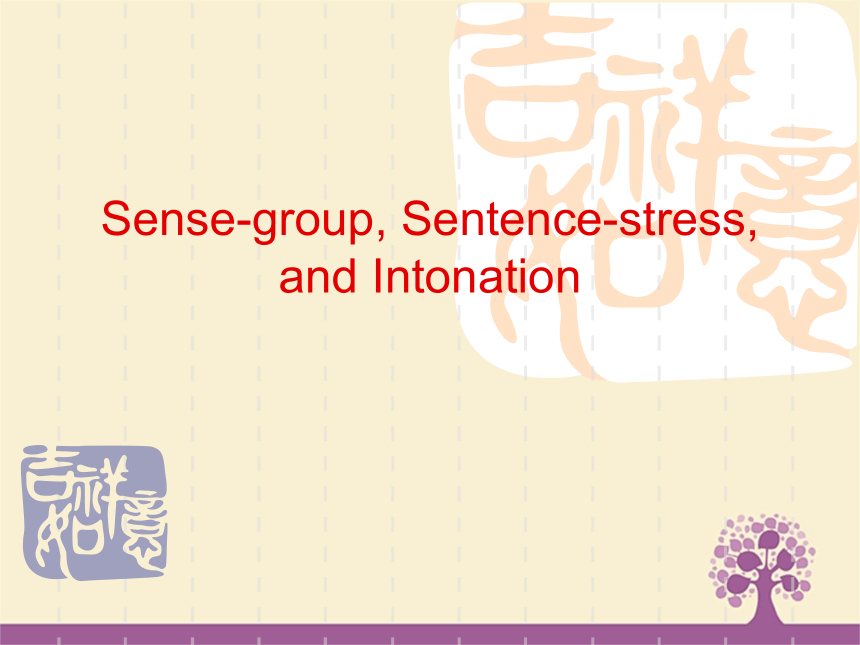 | |
| 格式 | ppt | ||
| 文件大小 | 413.5KB | ||
| 资源类型 | 教案 | ||
| 版本资源 | 通用版 | ||
| 科目 | 英语 | ||
| 更新时间 | 2023-01-03 21:55:19 | ||
图片预览


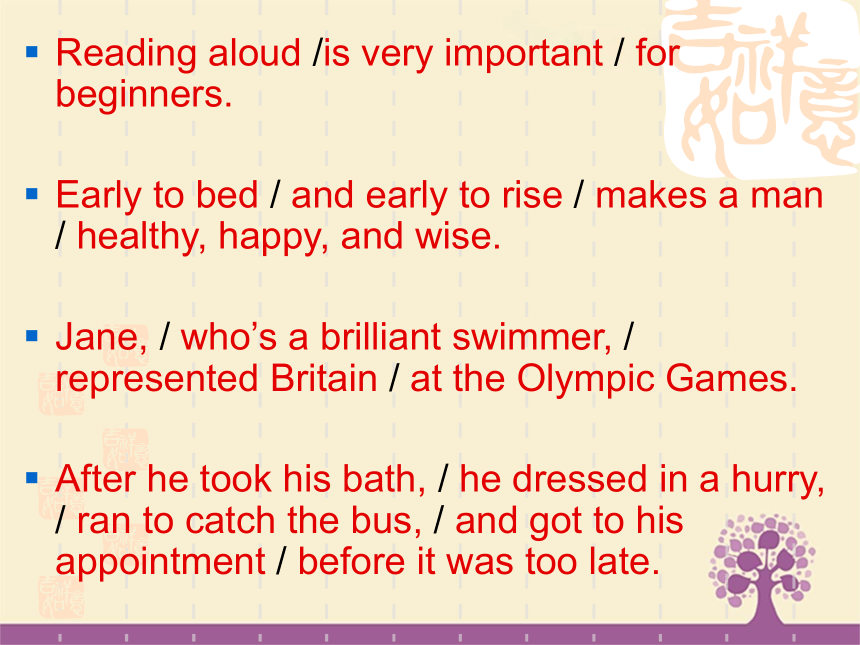
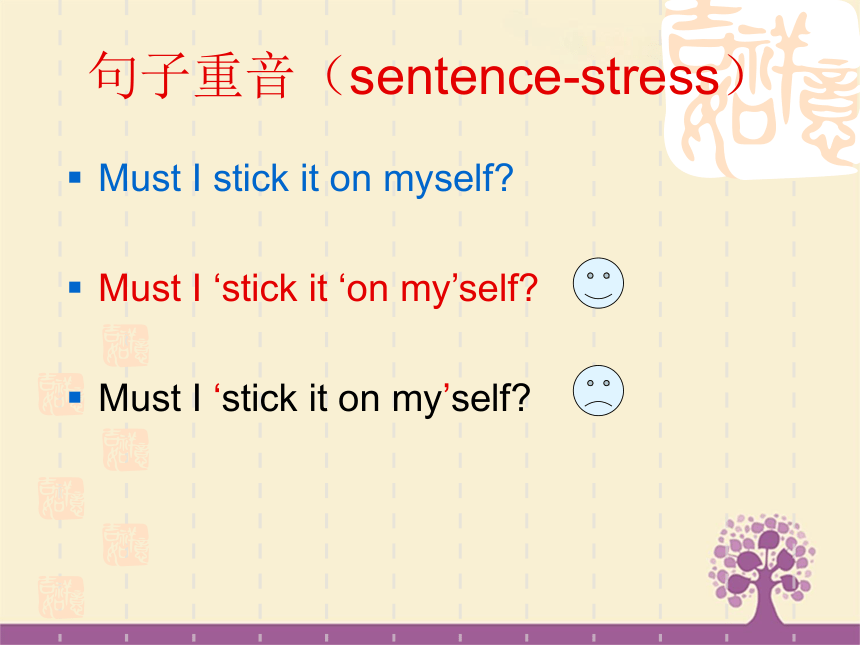
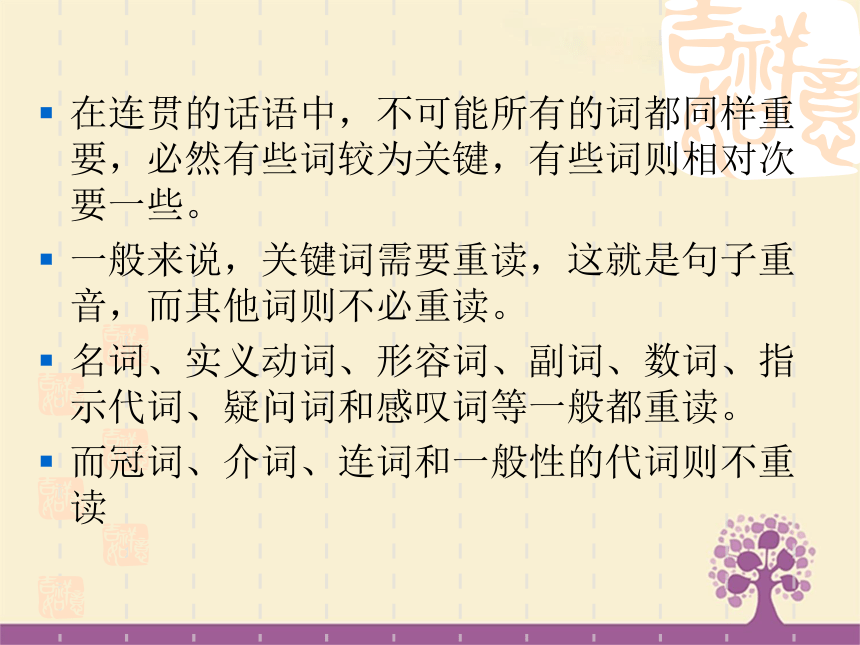
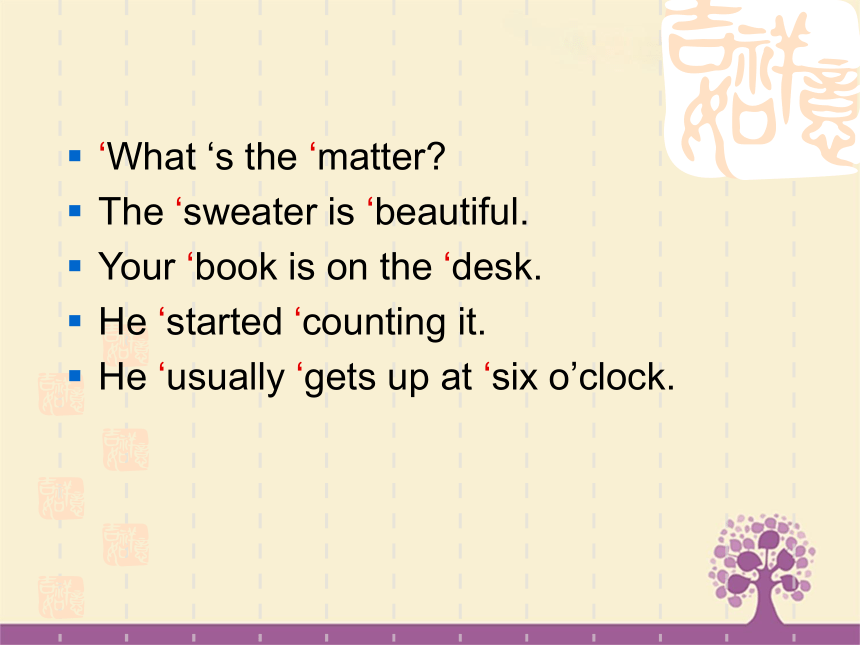
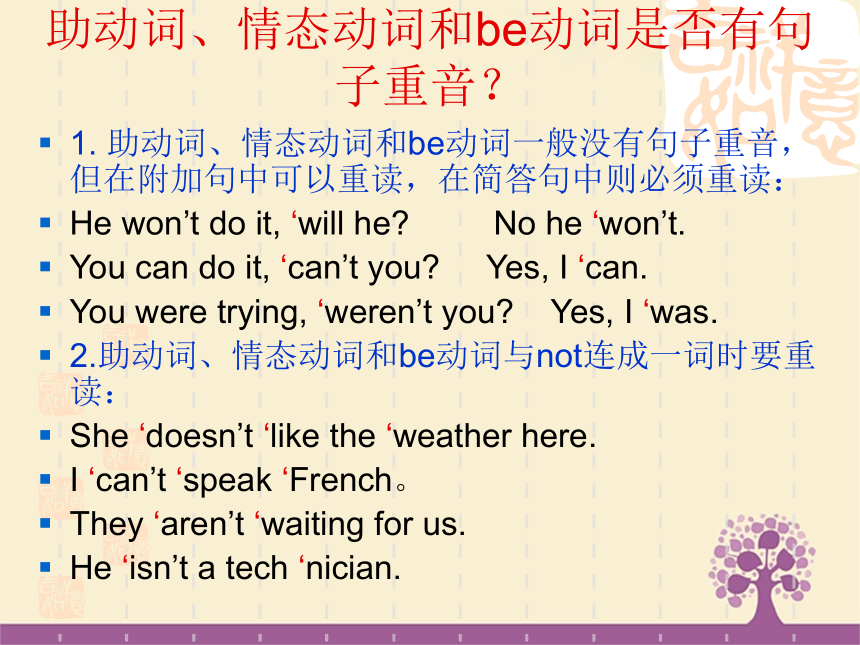
文档简介
(共17张PPT)
Sense-group, Sentence-stress, and Intonation
意群(sense-group)
意群就是指句子中按意思和语法结构划分出的各个成分,每一个成分即称为一个意群。同一意群中的词与词的关系紧密相关,密不可分,否则就会引起误解。
意群和意群之间可以有一定的停顿,这种停顿和人们的思维活动是一致的,但一个意群中的各个单词之间则不可停顿,整个意群读下来就像一个长单词一样。
注意:意群之间的停顿是根据说话人情况而定,并非一定要停顿不可。但如有停顿,则必在意群之间,随意乱停就破坏了语言的节奏。
Reading aloud /is very important / for beginners.
Early to bed / and early to rise / makes a man / healthy, happy, and wise.
Jane, / who’s a brilliant swimmer, / represented Britain / at the Olympic Games.
After he took his bath, / he dressed in a hurry, / ran to catch the bus, / and got to his appointment / before it was too late.
句子重音(sentence-stress)
Must I stick it on myself
Must I ‘stick it ‘on my’self
Must I ‘stick it on my’self
在连贯的话语中,不可能所有的词都同样重要,必然有些词较为关键,有些词则相对次要一些。
一般来说,关键词需要重读,这就是句子重音,而其他词则不必重读。
名词、实义动词、形容词、副词、数词、指示代词、疑问词和感叹词等一般都重读。
而冠词、介词、连词和一般性的代词则不重读
‘What ‘s the ‘matter
The ‘sweater is ‘beautiful.
Your ‘book is on the ‘desk.
He ‘started ‘counting it.
He ‘usually ‘gets up at ‘six o’clock.
助动词、情态动词和be动词是否有句子重音?
1. 助动词、情态动词和be动词一般没有句子重音,但在附加句中可以重读,在简答句中则必须重读:
He won’t do it, ‘will he No he ‘won’t.
You can do it, ‘can’t you Yes, I ‘can.
You were trying, ‘weren’t you Yes, I ‘was.
2.助动词、情态动词和be动词与not连成一词时要重读:
She ‘doesn’t ‘like the ‘weather here.
I ‘can’t ‘speak ‘French。
They ‘aren’t ‘waiting for us.
He ‘isn’t a tech ‘nician.
3.be用在一般疑问句句首时,重读与否均可:
‘Is he a ‘worker
Is he a ‘worker
比较句中的重音
在比较句中,重音落在as或than后的代(名)词上:
This is better than ‘that.
John is taller than ‘Bill.
She’s as happy as a ‘lark.
He’s as sly as a ‘fox.
逻辑重音
句子的重音总是要表现说话人的思想和他所要表达的意思的重点。有时为了强调,句子中几乎任何词都可以有句子重音,包括一些通常没有句子重音的词,这种依说话者意图重读的音就是逻辑重音。
Are you ‘angry with me
Are you ‘angry with ‘me
Are ‘you ‘angry with me
Did you tell my ‘wife
Did you tell ‘my wife
Did ‘you tell my wife
We ‘heard ‘John ‘talking.
We ‘heard John talking.
We heard ‘John talking.
语调
英语语调主要有降调、升调和平调三大类。
不同的语调可以表示说话人不同的态度和不同的隐含意思。
英语中同一句话采用不同的语调会产生截然不同的语意概念。如“Yes”
语调具有强烈的感彩,它使语言更富有表现力。
降调
用于陈述句
I have already read that book. ↘
That street is two miles long. ↘
用于特殊疑问句
What has happened to him ↘
Which direction is it to the post office ↘
注意:特殊疑问句有时可用升调表示请别人重复刚说过的话:
What is your major ↗
Where shall we go for the holiday ↗
用于祈使句
Go back to your seat! ↘
Please do not hesitate to contact me. ↘
用于感叹句
What a small world! ↘
Oh! My poor Mathilde, how you’ve changed! ↘
用于选择疑问句中“or”之后的部分
Do you want to ride or walk ↘
Would you like coffee or tea ↘
升调
用于一般疑问句
Do you mind if I sit here ↗
Can you hand in your compositions today ↗
注意:一般疑问句有时也可用降调,表示一种不耐烦的口气,或表示命令等。
Are you satisfied ↘
Will you take off your hat, please ↘
用于罗列中最后一项之前的各项
For each incomplete sentence, there are four choices marked A↗, B↗, C↗, and D. ↘
We study Chinese ↗, history ↗, geography ↗, and English. ↘
用于陈述句,表示疑问、怀疑、未定、猜测或期待等
Your really want to do it ↗
She might have gone. ↗
I think so. ↗
用于置于句首的状语短语或状语从句
After dinner ↗, I read a magazine and made telephone calls. ↘
While you were writing letters ↗, I was reading a book. ↘
用于并列句的第一个分句,表示句子还未说完
My fever is gone ↗, but I still have a cough. ↘
My major is English ↗, and I like it. ↘
用于委婉祈使句
Excuse me, sir ↗. Can you help me ↗
用于称呼语
Mrs. Smith ↗, this is Tom Jones. ↘
平调
用于直接引语后,表示话是谁说的
“We are going to Florida,” she said brightly. →
“How do you feel, boy ” I asked him. →
Sense-group, Sentence-stress, and Intonation
意群(sense-group)
意群就是指句子中按意思和语法结构划分出的各个成分,每一个成分即称为一个意群。同一意群中的词与词的关系紧密相关,密不可分,否则就会引起误解。
意群和意群之间可以有一定的停顿,这种停顿和人们的思维活动是一致的,但一个意群中的各个单词之间则不可停顿,整个意群读下来就像一个长单词一样。
注意:意群之间的停顿是根据说话人情况而定,并非一定要停顿不可。但如有停顿,则必在意群之间,随意乱停就破坏了语言的节奏。
Reading aloud /is very important / for beginners.
Early to bed / and early to rise / makes a man / healthy, happy, and wise.
Jane, / who’s a brilliant swimmer, / represented Britain / at the Olympic Games.
After he took his bath, / he dressed in a hurry, / ran to catch the bus, / and got to his appointment / before it was too late.
句子重音(sentence-stress)
Must I stick it on myself
Must I ‘stick it ‘on my’self
Must I ‘stick it on my’self
在连贯的话语中,不可能所有的词都同样重要,必然有些词较为关键,有些词则相对次要一些。
一般来说,关键词需要重读,这就是句子重音,而其他词则不必重读。
名词、实义动词、形容词、副词、数词、指示代词、疑问词和感叹词等一般都重读。
而冠词、介词、连词和一般性的代词则不重读
‘What ‘s the ‘matter
The ‘sweater is ‘beautiful.
Your ‘book is on the ‘desk.
He ‘started ‘counting it.
He ‘usually ‘gets up at ‘six o’clock.
助动词、情态动词和be动词是否有句子重音?
1. 助动词、情态动词和be动词一般没有句子重音,但在附加句中可以重读,在简答句中则必须重读:
He won’t do it, ‘will he No he ‘won’t.
You can do it, ‘can’t you Yes, I ‘can.
You were trying, ‘weren’t you Yes, I ‘was.
2.助动词、情态动词和be动词与not连成一词时要重读:
She ‘doesn’t ‘like the ‘weather here.
I ‘can’t ‘speak ‘French。
They ‘aren’t ‘waiting for us.
He ‘isn’t a tech ‘nician.
3.be用在一般疑问句句首时,重读与否均可:
‘Is he a ‘worker
Is he a ‘worker
比较句中的重音
在比较句中,重音落在as或than后的代(名)词上:
This is better than ‘that.
John is taller than ‘Bill.
She’s as happy as a ‘lark.
He’s as sly as a ‘fox.
逻辑重音
句子的重音总是要表现说话人的思想和他所要表达的意思的重点。有时为了强调,句子中几乎任何词都可以有句子重音,包括一些通常没有句子重音的词,这种依说话者意图重读的音就是逻辑重音。
Are you ‘angry with me
Are you ‘angry with ‘me
Are ‘you ‘angry with me
Did you tell my ‘wife
Did you tell ‘my wife
Did ‘you tell my wife
We ‘heard ‘John ‘talking.
We ‘heard John talking.
We heard ‘John talking.
语调
英语语调主要有降调、升调和平调三大类。
不同的语调可以表示说话人不同的态度和不同的隐含意思。
英语中同一句话采用不同的语调会产生截然不同的语意概念。如“Yes”
语调具有强烈的感彩,它使语言更富有表现力。
降调
用于陈述句
I have already read that book. ↘
That street is two miles long. ↘
用于特殊疑问句
What has happened to him ↘
Which direction is it to the post office ↘
注意:特殊疑问句有时可用升调表示请别人重复刚说过的话:
What is your major ↗
Where shall we go for the holiday ↗
用于祈使句
Go back to your seat! ↘
Please do not hesitate to contact me. ↘
用于感叹句
What a small world! ↘
Oh! My poor Mathilde, how you’ve changed! ↘
用于选择疑问句中“or”之后的部分
Do you want to ride or walk ↘
Would you like coffee or tea ↘
升调
用于一般疑问句
Do you mind if I sit here ↗
Can you hand in your compositions today ↗
注意:一般疑问句有时也可用降调,表示一种不耐烦的口气,或表示命令等。
Are you satisfied ↘
Will you take off your hat, please ↘
用于罗列中最后一项之前的各项
For each incomplete sentence, there are four choices marked A↗, B↗, C↗, and D. ↘
We study Chinese ↗, history ↗, geography ↗, and English. ↘
用于陈述句,表示疑问、怀疑、未定、猜测或期待等
Your really want to do it ↗
She might have gone. ↗
I think so. ↗
用于置于句首的状语短语或状语从句
After dinner ↗, I read a magazine and made telephone calls. ↘
While you were writing letters ↗, I was reading a book. ↘
用于并列句的第一个分句,表示句子还未说完
My fever is gone ↗, but I still have a cough. ↘
My major is English ↗, and I like it. ↘
用于委婉祈使句
Excuse me, sir ↗. Can you help me ↗
用于称呼语
Mrs. Smith ↗, this is Tom Jones. ↘
平调
用于直接引语后,表示话是谁说的
“We are going to Florida,” she said brightly. →
“How do you feel, boy ” I asked him. →
